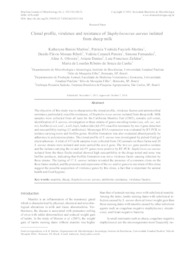Clonal profile, virulence and resistance of Staphylococcus aureus isolated from sheep milk.
Clonal profile, virulence and resistance of Staphylococcus aureus isolated from sheep milk.
Author(s): MARTINS, K. B.; FACCIOLI-MARTINS, P. Y.; RIBOLI, D. F. M.; PEREIRA, V. C.; FERNANDES, S.; OLIVEIRA, A. A.; DANTAS, A.; ZAFALON, L. F.; CUNHA, M. de L. R. de S. da
Summary: The objective of this study was to characterize the clonal profile, virulence factors and antimicrobial resistance, particularly oxacillin resistance, of Staphylococcus aureus isolated from sheep milk. Milk samples were collected from all teats for the California Mastitis Test (CMT), somatic cell count, identification of S. aureus, investigation in these strains of genes encoding toxins (sea, seb, sec, sed, tst), biofilm (icaA, icaC, icaD, bap), leukocidin (luk-PV) oxacillin resistance by mecA gene detection and susceptibility testing (12 antibiotics). Messenger RNA expression was evaluated by RT-PCR in isolates carrying toxin and biofilm genes. Biofilm formation was also evaluated phenotypically by adherence to polystyrene plates. The clonal profile of S. aureus was investigated by pulsed-field gel electrophoresis. A total of 473 milk samples were collected from 242 animals on three farms and 20 S. aureus strains were isolated and none carried the mecA gene. The two sec gene-positive isolates and the isolates carrying the tst and luk-PV genes were positive by RT-PCR. Staphylococcus aureus isolated from the three flocks studied showed high susceptibility to the drugs tested and none was biofilm producer, indicating that biofilm formation was not a virulence factor causing infection by these strains. The typing of 17 S. aureus isolates revealed the presence of a common clone on the three farms studied, and the presence and expression of the sec and tst genes in one strain of this clone suggest the possible acquisition of virulence genes by this clone, a fact that is important for animal health and food hygiene.
Publication year: 2015
Types of publication: Journal article
Keywords: Staphylococcus Aureus, Virulence factors, antibiotic resistance, mastitis, sheep
Observation
Some of Embrapa's publications are published as ePub files. To read them, use or download one of the following free software options to your computer or mobile device. Android: Google Play Books; IOS: iBooks; Windows and Linux: Calibre.
Access other publications
Access the Agricultural Research Database (BDPA) to consult Embrapa's full library collection and records.
Visit Embrapa Bookstore to purchase books and other publications sold by Embrapa.

